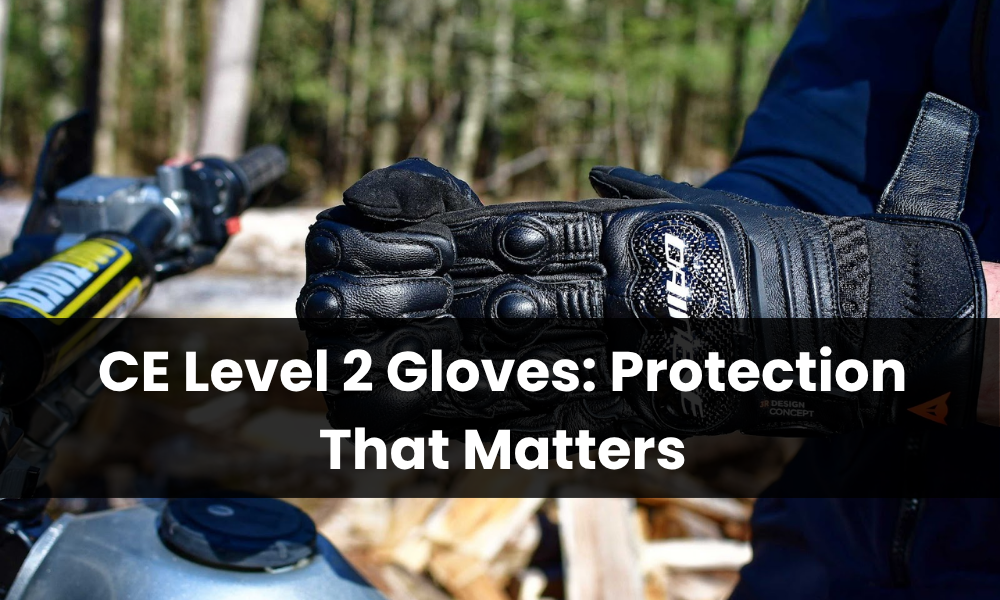CE Level 2 Gloves: Protection That Matters

There’s always that moment when everything slows down. The bike starts sliding, hands go out instinctively, and the pavement rushes up fast. What happens next depends entirely on what’s covering those hands.
Most riders spend hours researching helmets and jackets, but gloves often get treated like an afterthought. That’s a mistake. A solid best safest motorcycle gloves ce level 2 buying guide can make the difference between walking away from a fall and dealing with broken bones or road rash that takes months to heal.
Understanding CE Level 2 Protection Standards
CE certification sounds fancy, but it’s really just proof that gloves got tested properly. Real crash testing, not just marketing fluff. Level 2 protection means the gloves passed tougher impact tests than Level 1 options. When something hits the armor, it absorbs more force before anything reaches the actual knuckles and fingers.
Testing labs put CE approved motorcycle gloves through serious punishment. They drop heavy weights onto the armor and measure how much force gets through. Level 2 armor has to keep that force under 9 kilonewtons, while Level 1 just needs to stay under 14. Smaller numbers are better here because less force means less damage to bones.
Plus these gloves use materials that actually hold together when scraping across rough pavement instead of shredding like tissue paper. The testers also yank on the seams to see if they’ll rip open when stressed. That whole process is why CE certified motorcycle gloves matter more than ones that just look tough but haven’t proven anything.
Key Features That Define Quality Protection
Everything starts with the materials. Good thick leather is still one of the best choices because it does not tear easily. At the same time, modern fabrics like Cordura and Kevlar offer impressive strength while allowing more flexibility for your hands.
The best motorcycle gloves often combine both. Leather is used in areas that face the most wear, while softer fabrics are placed where movement matters more. But real protection goes beyond just covering your knuckles.
High-quality gloves include CE Level 2 knuckle guards for strong impact resistance, small sliders on the fingers and palms to stop joints from twisting during a fall, solid wrist support to prevent your hands from bending backward, and reinforced stitching in the areas that take the hardest hits.
Many riders overlook the palm area, even though it usually hits the ground first in an accident. Having two or three layers of material with extra padding can protect your hands from serious injury while still letting you feel the bike’s grip.
It is also important to check how the glove fits around the wrist. A longer, secure design keeps it from slipping off during impact and helps block dirt and small rocks from getting inside.
Balancing Protection With Comfort and Dexterity
The toughest gloves ever made are worthless sitting at home collecting dust. Finding the best moto gloves means getting something protective enough to matter but comfortable enough to actually wear on every ride. Fingers that come pre shaped to match how hands naturally curl make a huge difference on those all day rides when everything starts cramping up.
Temperature control features completely change how gloves perform. Mesh sections prevent that gross sweaty hand feeling on scorching days, particularly when paired with airy summer motorbike jackets. Throw in some warm liners and waterproof barriers and suddenly riding stays possible even when it gets cold, kind of like having proper rain pants motorcycle gear keeps the lower half dry.
Touchscreen fingertips went from being a nice bonus to basically required. Most men’s motorbike gloves now build in special material on the fingertips that lets phones and GPS units work without stripping off protection. That becomes really handy on longer trips when constantly checking directions or dealing with calls.
Fit Considerations That Actually Matter
Getting the right fit turns okay gloves into great ones. Squeezing into something too tight chokes off blood flow and makes everything go numb. Going too loose creates bunching that messes with control. Wrapping a tape measure around the widest part of the palm gives a rough idea, but nothing beats actually putting gloves on because brands size things all over the place.
Where the fingers end compared to where that knuckle armor sits determines whether the protection actually does its job. Those hard protective bits need to line up directly over the knuckles, not hanging in space above them or jamming into the joints. The straps around the wrist need enough give to close properly whether wearing a thin motorcycle jacket summer or bulky winter layers.
Quality leather takes time to break in properly. It starts stiff then loosens up while staying strong, unlike bargain gloves that just disintegrate. Brand new safest motorcycle gloves might feel restrictive initially but should never cause actual pain or make fingers tingle because circulation got cut off.
Maintenance Practices That Extend Glove Lifespan
Spending good money on gear means taking care of it makes sense. Leather needs conditioning treatment periodically or it dries out and cracks apart. Stick with products designed for motorcycle gear instead of whatever leather conditioner happens to be on sale.
Textile options need washing according to whatever instructions came with them, which usually means gentle hand washing because machines destroy waterproof membranes. Storage location matters way more than expected. Leaving gloves baking in direct sunlight or hot enclosed spaces breaks materials down fast.
Tossing them somewhere cool and dry keeps everything working longer. Taking a minute to inspect the armor occasionally catches problems before they become serious. Seeing cracks or compressed foam means those gloves need replacing.
Ready to step up the hand protection game? Swing by Six Gear to browse premium best riding gloves motorcycle options that nail both the safety and comfort angles.
Common Mistakes When Selecting Protective Gloves
Going cheap to save a few bucks ranks as the biggest mistake possible. Budget gloves might stuff some foam in there, but actual verified CE Level 2 certification almost never makes an appearance. The price gap between okay and excellent protection usually costs about the same as filling the tank once, which makes this a terrible place to pinch pennies when talking about bones staying intact.
Trying to use one pair of gloves all year creates constant problems. Having different pairs for different conditions, similar to owning both the best motorcycle rain suit gear and summer stuff, means protection stays solid regardless of weather. Attempting to force one pair to work for everything always ends with giving up either safety or comfort.
Assuming hands all fit the same way leads to frustration. Hands come in way more shapes than just small, medium, and large, and manufacturers build gloves accounting for these variations. Following a solid best safest motorcycle gloves CE level 2 buying guide means testing multiple brands because how different companies size their products varies more dramatically than size differences within the same brand.
FAQs
- What does CE Level 2 certification actually mean for motorcycle gloves?
Level 2 certification shows the gloves survived tougher impact testing compared to Level 1, keeping transmitted forces under 9 kilonewtons during standardized drops, which translates to better hand protection when things go wrong.
- How often should protective motorcycle gloves be replaced?
Replace them immediately after any crash involving hand contact, whenever armor shows visible damage, or when materials start deteriorating. Under normal riding conditions, decent gloves typically hold up for roughly 2 to 3 years.
- Can summer gloves offer CE Level 2 protection?
Absolutely. Modern material technology allows manufacturers to build well ventilated gloves that still pack full CE Level 2 certification, proving serious protection doesn’t require suffering through sweltering rides.
- Do CE Level 2 gloves work with touchscreen devices?
Plenty of current motorcycle riding gloves incorporate conductive fingertip materials for touchscreen compatibility, though not every model includes this feature, so verifying before purchase matters.
- What’s the difference between gauntlet and short cuff protective gloves?
Gauntlet designs extend over jacket sleeves, eliminating gaps while providing wrist coverage. Short cuff versions slide under sleeves, offering more flexibility but protecting less overall area.



